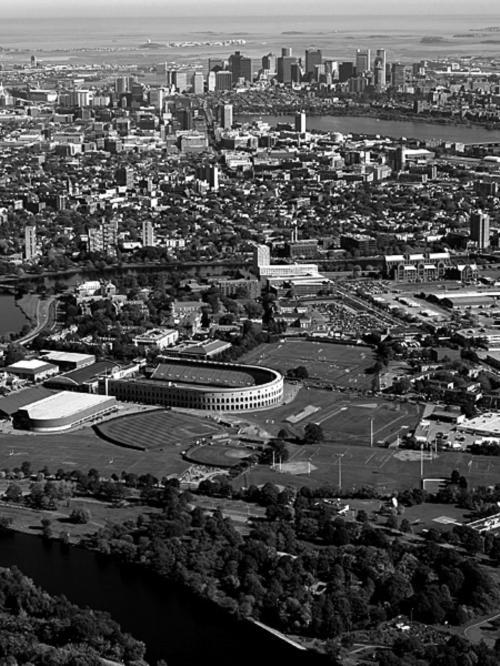Allston is the hope and promise of Harvard’s long-term future. Getting it right will shape the character of the University for generations. But we could easily get it wrong.
Here’s one entirely imaginable dystopic future that Harvard could build, all too easily, by laying down entirely rational paving stones one-by-one. First, we identify ambitious, important scientific programs, especially in the biosciences, that will not fit into the available land in Cambridge but that could be prosecuted collaboratively by the Faculty of Arts and Sciences (FAS) and the Harvard Medical School (HMS). Second, we move the Harvard School of Education and the School of Public Health to Allston to form a linked cluster with the Harvard Business School. Third, to provide some “life” over in Allston, we import three undergraduate houses and some retail shops. Fourth, we plan for a cultural institution, probably a contemporary annex to the Cambridge museums. Given these four constraints, we arrange the building blocks to satisfy the flow of people and infrastructure. Each step thoroughly sensible, the “program” handled professionally.
We could end up with a supercharged overflow unit, a suburban science park with a cultural “capstone,” and hundreds of students lodged in nicely landscaped dorms. Follow me in a quick mental tour of my “dys-Allston”: You have no problem, I am sure, imagining a science campus that by 6:30 p.m. is abandoned, at least from the outside. The stunning new museum closes at 5 p.m. (it is a superb collection—most faculty and students go once, to show visitors). There are some classrooms in dys-Allston, but since courses ended by 4 p.m., the rooms are dark except for the blackboard washer. An occasional bike rider zips down an empty street on her way “back” to Harvard Square. Looming big-block buildings maximize floor space. These buildings of glass and steel carry strong, welcoming sandstone entryways announcing the Harvard X, Y, or Z-nomics Center. The only sounds are those of wind, windshield wipers, a few quiet conversations by the shuttle bus stop, and the rumble of air conditioning systems.
I love the science that I imagine in this scenario—and am delighted at the idea that we will get some star architecture. But the whole scene is, for me, an absolute nightmare—and an absolutely possible nightmare.
This scene isn’t a nightmare to me because the science is bad; we have an unbelievably talented collection of faculty and students—we’ll get that right. It isn’t a nightmare because we hired mediocre architects; by 2007 the urgency of good design has been received loud and clear—we’ll get that right too. It isn’t even that we forgot “culture” or neglected students (every Allston discussion I’ve heard and plan I’ve seen has undergraduate housing and a museum).
No, the problem is that Allston cannot—must not—be thought of entirely as a way-station between FAS and HMS; nor can it be an annex to carry overflow housing, lab, and museum space that doesn’t fit in Cambridge. Allston must be thought of as a fundamental piece of the dynamic center of Harvard University. Here’s the acid test: It is 6:30 p.m. or 9:30 p.m. on a Thursday or Friday or Saturday—and if you don’t think it would be great to go to Allston, if “back to the Square” is on the tip of your tongue and you would never think of going “back to Allston,” then we will have failed.
That vibrant centrality of Allston is a lot harder to imagine than commissioning a renowned architect or routing the shuttle bus for 12-minute pickup intervals. Making Allston a center, not an annex, is going to be exceedingly hard—there is no magic bullet. But one foundational—not decorative—element of Allston (and therefore of Harvard) ought to be the arts alongside the sciences. A science park with dorms and high-end retail shops is not enough; my utopia Allston includes that fabulous science, the dorms and shops—alongside a cacophony of film editing studios, a jazz club, off-beat cafés that are open late, music performance spaces, and alternative theater showcases.
I’d like to see student and faculty painting and sculpture studios hard against biotech lab space. My wish is for a museum with gems of modern and contemporary art and space for experimental recent work by visiting artists, students, and faculty. There should be theatre at the level of the best of the American Repertory Theatre and a full range of amateur performing art. We’ll need film spaces for viewing the fabulous Harvard Film Archive as well as new and unusual work. We will need faculty, courses, and resources commensurate with student demand.
Most importantly, this isn’t a question of adding art to a science park the way one might humanize a workspace by adding a fountain with picnic benches. It would require building the arts into a much larger component of what we stand for Harvard. This will not happen by adding a couple of positions to this or that department, and it won’t come cheaply. Institutions comparable to ours are spending hundreds of millions of dollars on the arts; we have no head start. It means thinking of the arts alongside the natural sciences, social sciences, and humanities as central to Harvard. President-elect Drew G. Faust has made one of her priorities the planning for a much stronger theater and visual arts presence. Binding Allston to Cambridge would be a powerful way to launch that vision.
For all too long, both engineering-inflected science (increasingly central to science in Cambridge and to plans for the science part of Allston) and the arts have been relegated to a second place. A lingering 19th century fear of the applied remains—as if hands-on work might contaminate scholarly purity. We have the confidence and competence to shed that legacy: We don’t any longer have to live a 19th century vision—and we shouldn’t. Times have changed.
Peter L. Galison ’77 is Pellegrino University Professor.
Read more in Opinion
Five Reasons for Reason and Faith













